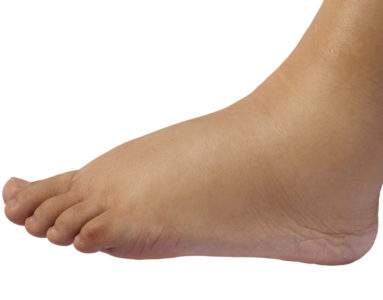 Diabetics are typically plagued by circulation issues in their extremities, so it should come as no surprise that swelling is a common problem that develops, especially in the feet where gravity helps to pull fluids downward. Swollen feet may not seem like a big deal, especially if they are not painful, but they can lead to a host of complications and health problems. That’s why it’s so important to take some steps to reduce swelling in your feet if you’re diabetic.
Diabetics are typically plagued by circulation issues in their extremities, so it should come as no surprise that swelling is a common problem that develops, especially in the feet where gravity helps to pull fluids downward. Swollen feet may not seem like a big deal, especially if they are not painful, but they can lead to a host of complications and health problems. That’s why it’s so important to take some steps to reduce swelling in your feet if you’re diabetic.
In today’s blog, we share five tips for caring for swollen feet if you have diabetes.
Caring For Swollen Diabetic Feet
If you’ve noticed that your diabetic feet are swelling or retaining fluid more frequently, consider these five actions to help improve fluid movement in and out of the area.
1. Move – Movement helps to get our blood pumping and moving around our body, so get up and move around. Strive to get regular exercise and break up long sedentary periods. This will help to get fluid buildup moving and promote an overall healthy lifestyle.
2. Elevate – If you’re going to spend some time sitting, do it with your feet elevated above your heart. Lay down and prop your feet up on some pillows to make them the highest point on your body. Now gravity will be working in your favor to help drain fluid from your feet and ankles.
3. Compress – Compression socks or stockings are designed to help improve lymphatic flow to and from our feet, and it’s a very passive treatment to pursue, so invest in a couple of pairs of compression socks. The compression gently helps to push blood flow up the leg to help prevent excess swelling and pooling.
4. Drink Plenty of Water – Drinking water may seem like it’s only going to increase the amount of fluid in your body, but water helps to open up blood vessels so that blood can move around more easily. If you drink 8-10 glasses of water throughout the day, you’ll help to keep your body hydrated and your blood vessels open, improving the movement of fluid in your extremities. Staying hydrated is another low effort technique that can really help to reduce fluid retention.
5. Review Your Medications – Some side effects of certain medications include the possibility of blood clots or an increased risk of swelling in the extremities. Really take a closer look at your prescriptions and talk to your doctor to see if your medication could be increasing your swelling risk. See if there are any other treatments that can be as effective without the potential side effects.